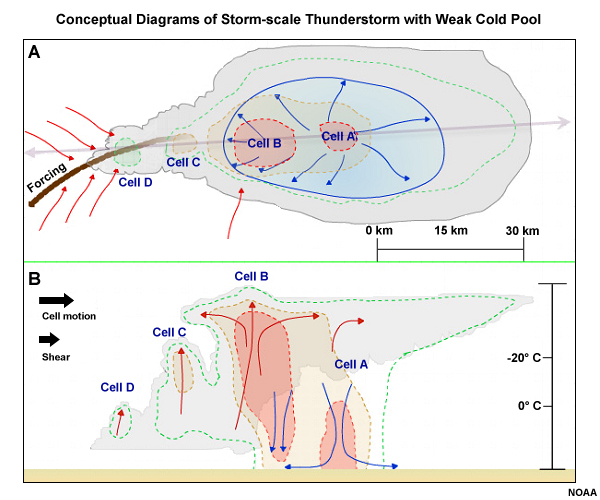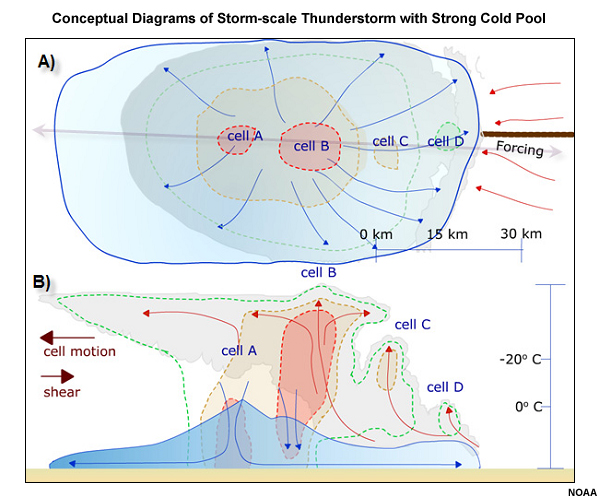Definition of Pulse and Multicell Storms
Small multicell storms consist of a number of individual cells in close proximity to each other. These individual cells might share a common precipitation volume, cloud material or a common cold pool. New cells usually initiate before older cells dissipate which means that multicells tend to live considerably longer than any individual updraft.
The focus here is on meso-γ scale (2-20 km; Orlanski 1975) thunderstorms in a low shear environment, or in plainer words, "storm-scale" thunderstorms as opposed to mesoscale convective systems (MCSs). Understanding the environmental deep-layer shear and the system's cold pool strength, two of the more influential drivers of thunderstorm development, provides insight on these storms' appearance and behaviour. In this section we only consider "low shear" environments, subjectively set to 0-25 kts of 0-6 km bulk shear. "High shear" regimes of with 25+ kts of 0-6 km shear are more adequately described in the Supercell and MCS conceptual models.
An organised small multicell is characterised by frequent initiation of new cells which are stronger than their unorganised counterparts. Organising updrafts trend from short-lived pulses to increasingly longer-lived plume-like updrafts that ultimately trend towards supercell characteristics as the ambient deep layer shear and instability is increased.
Among the factors that determine the appearance and behaviour of small multicells are:
- cold pool,
- vertical shear,
- forcing (physical process associated with initation of new deep updrafts),
- ambient instability,
- storm-relative winds,
- and other factors.
For small multicells in weak deep layer shear, the cold pool strength is one of the more influential drivers.
Weak Cold Pool Storm-Scale Multicells
In the weak cold pool scenario (fig. 1), the initiation of new cells is controlled by an external forcing mechanism such as cold fronts, gravity waves or differential heating. New cells tend to form along the axis of forcing, outside the relatively small system cold pool. Depending on the arrangement of the forcing relative to the system, cold pool deficient multicells can propagate backwards (in this case to the left), despite individual cells moving in the opposite direction with the steering flow (in this case to the right). The partial cancellation of propagation and cell motion can lead to a very slow-moving system, enhancing the risk of flash flooding. The weak cold pool multicell shape and movement matches that of the external forcing.

Fig. 1: Top down (A) and side-on (B) views of a conceptual multicell with a weak cold pool which is highlighted in a light blue shading. Cloud is shown in grey shading, approximate 20, 40, 50 dBZ radar reflectivity values are outlined in green, tan, and red dotted lines, respectively. Low level inflow (outflow) is shown in red (blue) streamlines. The double arrow in (A) shows the axis of the vertical cross section shown in (B). In (B), red arrows show updrafts, blue arrows show downdrafts.
Strong Cold Pool Storm-Scale Multicells
In the case of small multicells with a strong cold pool (fig. 2), the initiation of new cells is controlled by the system's cold pool itself. New cell initiation is primarily forced along the leading edge of the cold pool (gust front), and is modulated by environmental factors such as wind shear or instability. The gust front tends to move faster than the individual cells in a low shear setup so that cells initiate, mature as they fall behind the gust front and dissipate as elevated cells on top of the system cold pool. The continual new cell initiation along the fast moving gust front leads to a forward propagating system.

Fig. 1: Conceptual model of a small multicell with a strong cold pool (shaded in blue). Cloud is shown in grey shading, approximate 20, 40, 50 dBZ radar reflectivity values are outlined in green, tan, and red dotted lines, respectively. Low level inflow (outflow) is shown in red (blue) streamlines. The double arrow in (A) shows the axis of the vertical cross section shown in (B). In (B), red arrows show updrafts, blue arrows show downdrafts.
Transition from Weak- to Strong Cold Pool Storm-Scale Multicells
Most small multicells tend to form a deepening and expanding cold pool if they persist or grow upscale. In such an event the system is more likely to initiate new cells along its gust front and become cold pool dominant. This type of transition may also be associated with a distinct change in system movement as cold pool driven propagation is now altering the previous system motion vector.
